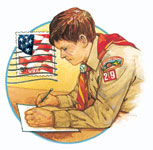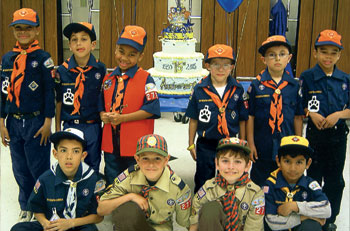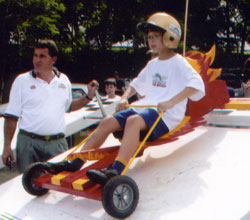
Letters
No 'camouflage' uniforms
My troop participated in a joint troop service project last spring, and...another troop [had] its members wearing full camouflage clothing, with the striking appearance of being members of the U.S. Army rather than Boy Scouts.
Our congressional charter prohibits Scouts appearing as a paramilitary unit [which is why we have] the restriction against wearing any form of camouflage "clothing."
Daniel Ketcham
Scoutmaster, Troop 855
Executive Board Member, Golden Empire Council
Cedar Ridge, Calif.
According to the Rules and Regulations of the Boy Scouts of America (BSA No. 57-492), under "Insignia, Uniforms, and Badges," Clause 4(b) states: "Imitation of United States Army, Navy, Air Force, or Marine Corps uniforms is prohibited, in accordance with the provisions of the organization's Charter."
Kids aren't cargo
I recently attended an outdoor event in the mountains of southeast Utah with more than a hundred adults and youth, including several Scout troops. As we headed up the mountain, six to eight Scouts were riding in the back of a pickup truck in front of us. Over the rough terrain, I could see them bounce and lean and hold on.
While we made it to our destination safely, each year more than 200 deaths occur among passengers in the cargo areas of pickup trucks. More than half of these deaths are children and teenagers. Often these incidents are not on the highway, and many times, at speeds of 30 miles an hour or less.
As a mother of four boys very active in Scouting and a Scout leader myself, I'm concerned at [how some leaders ignore the BSA position against this practice], thinking the boys will be fine, nothing will happen.
The Guide to Safe Scouting (No. 34416E, or available online at www.scouting.org/pubs/gss) clearly states BSA policy: "Trucks are designed and constructed to transport materials and equipment, not people. The beds of trucks or trailers must never be used for carrying passengers. Tour permits will not be issued for any trip that involves carrying passengers in a truck except in the cab."
I'm ashamed for not having said something at the time. The rule against this practice is there for a very good reason. Let's all make a greater effort to see that it is enforced.
Ann Shumway
Elk Ridge, Utah
 Photograph By Cyndi Nevels At their blue and gold dinner in February, young members of Pack 273, of Union City, Calif., posed with their Cub Scouting 75th anniversary cake before helping to make it disappear. |
What a cake!
Pack 273 celebrated the 75th anniversary of Cub Scouting at our blue and gold dinner last February.
We had a special cake made to look just like the one on the cover of Scouting's January-February 2005 Cub Scouting 75th anniversary issue. The cake served about 180 people!
Cyndi Nevels
Treasurer, Pack 273
Union City, Calif.
Cub Scouting's 75th anniversary officially continues through December 2005, so there's still time for packs to plan special events or activities—or bake a cake—as part of their fall monthly program themes.
Grateful for Scouts and Scouting
I have been in Scouting since Tiger Cubs and received my Eagle Scout Award in 2000. While serving in the Air Force, I have been an adult leader with Troop 394 at Vandenberg (Calif.) Air Force Base.
After being deployed to Iraq in January, I realized how much of an impact Scouting has had on my life. I know that all the other Scouters who had to leave their troops and are now deployed to forward areas will agree with me that the training we received over the years of summer camps, camporees, and other activities has helped us with our operations.
I want to thank all of the Scouts and Scouters who make Scouting such a great youth program. (And special thanks to Troop 394 for the care package; all the items are being put to good use.)
Airman First Class James Spear (U.S.A.F.)
Detachment 1 732nd Expeditionary Mission
Support Group (Law and Order), Iraq
Canadian Scout exchange program celebrates 60 years
Visits between Canadian Scouts from Oshawa, Ontario, and American Scouts from Rochester, N.Y., started in spring 1945, when Canadian Scouter Alt Dunk arranged for more than 20 Scouts from his troop, 7th Oshawa, to visit their BSA counterparts across Lake Ontario.
That fall, Scouts from Rochester made a return visit to Oshawa. In the following years, more troops were involved, and the program became known as "Hands Across the Border." The visit of Oshawa Scouts to Rochester last spring marked its 60th anniversary.
During each trip, American and Canadian Scouts are paired up, with a visiting Scout living with a host Scout and his family. Activities during a visit to the United States might include a trip to Niagara Falls or other area attractions, and a tour of Rochester.
Competitive Scouting events are held on Saturday morning, and Scouts attend church services on Sunday. However, much of the weekend is free so Scouts can learn more about their counterparts, exploring the different ways they plan special Scout events.
Many friendships have evolved over the years, with whole families vacationing together and exchanging visits.
Richard Eggert
Committee Member, Troop 110
Otetiana Council
Rochester, N.Y.
Boy Scouts can also wear the Cub Scout religious emblem
In response to a comment in the May-June 2005 Front Line Stuff column that the Arrow of Light is the only Cub Scout Award worn on the Boy Scout uniform, the religious emblem knot, earned as a Cub Scout, may also be worn on the Boy Scout uniform.
The requirements for the Webelos badge include completing a religious activity or emblem. With that in mind, all Cub Scouts should cross over to Boy Scouts with a religious emblem knot on their uniform.
As Boy Scouts, they will repeat, "A Scout is...Reverent" many times, as one-twelfth, or one point, of the Scout Law. [Our committee] challenges Scouts and Scouters to make at least one-twelfth of their program dedicated to a religious activity.
We encourage the many troops in our diocese who are not Catholic to earn the religious emblem of their faith. Scouts can learn more about earning their faith's emblem at: P.R.A.Y. (Programs of Religious Activities with Youth) Publishing (www.praypub.org/main_frameset.htm). More on the National Catholic Committee on Scouting is available at www.nccs-bsa.org.
The Catholic Committee on Boy Scouting
Diocese of Columbus
Westerville, Ohio
www.cdeducation.org/oym/scouts
Cubmobile races are popular with Pack 304 in Puerto Rico
 Scouter Manuel Alvarez prepares to launch Bear Cub Scout Sebastian Claudio on a 150-foot Cubmobile run. Photography by Marcia Munoz |
Last September, Pack 304 staged a two-day Cub Scout Derby, an event held every two years.
Our pack, chartered to the Parish and Catholic School San Ignacio in Rio Piedras, has been in existence since 1985; we have approximately 70 members between the ages of 6 and 10.
On Saturday, the pack's eight dens took part in races. For Sunday's competition, for the first time, 50 Cub Scouts from 17 other packs from different towns on our island were invited to participate.
Each den and pack was responsible for building their car under specifications in the Cub Scout Leader How-To Book (BSA No. 33832A). The Cub Scouts helped in making and painting their cars, which were inspected by the judges before the races. (The key is to make the car as light as possible using the required materials, so it rolls as fast as possible. Most Cub Scouts had the opportunity to do a test on the track before the real race.)
The cars raced two at a time down a 150-foot track. Spectators cheered at each race with great enthusiasm.
We also had entertainment for little brothers and sisters, such as two inflatable bounce houses, racing tracks for miniature electric cars, music, and ice cream and other refreshments.
Maria Munoz
Assistant Webelos Den Leader, Pack 304
Guaynabo, Puerto Rico
Hats, on or off?
What is the official BSA policy concerning the wearing of the Scout hat indoors?
Specifically, can hats be worn during indoor meetings or [only] when saying the pledge indoors or retiring the flag at the end of an indoor meeting?
I've always felt the hat was part of the full uniform and could be worn at all times without disrespect, except during prayer or eating.
Jeff Williams
Assistant Scoutmaster, Troop 993
Houston, Tex.
According to the Insignia Guide (No. 33066E), "Official headgear may be worn while the unit or individual is participating in an indoor formal ceremony or service duty, except in religious institutions where custom forbids. Typical indoor activities of this type are flag ceremonies, inspections, orderly duty, or ushering service. In any informal indoor activity where no official ceremony is involved, the headgear is removed as when in street clothes."
High adventure questions
I recently read your October 2004 issue and thought the Canadian wilderness canoe trip sounded very exciting.
Is a high adventure trip like this recommended for younger Scouts? Is any special training required beforehand?
Dan McBride
Glenview, Ill.
Answers to these and many other questions can be found in the BSA publication Passport to High Adventure (No. 4310). Regarding your first question, Chapter 1, "Who Will Go?" says: "[High adventure] participants must be at least age 13 by January 1 of the year of attendance, or have completed the seventh grade [although] some of the more rugged high adventure experiences offered [by BSA councils and national programs] require an even higher minimum age for participation."
Chapter 6, "Skills Practice," discusses your question regarding training. Other chapters cover topics from planning, budget, promotion, and preparation to equipment, trek safety, the principles of Leave No Trace, and more.
A directory of council high adventure programs and specialty adventure programs is also included. Get the book at council service centers, Scout shops, or by phone, (800) 323-0732.
A troop orchestra
The Troop 623 orchestra was started about seven years ago by the father of one of our Scouts. Active in the music community as a band parent, he thought it would be good for the troop to offer musical entertainment to nursing homes. (The boys earn service hours for performing.)
We have about 25 members, with a full complement of instruments, including strings, woodwinds, brass, and percussion. We perform at nursing homes and have performed the processional for the fifth-grade graduation at a local elementary school.
Immediate family members also can participate, and Roy (the dad who started it all) still plays trombone, even though his son has graduated from high school and is no longer active in the troop.
We have a great time, and having a full orchestra gives many of the boys an opportunity they don't usually have in their school programs. It also gives them a chance to see how music can make a difference.
Judy Lindquist
Chesterfield, Mo.
'It's a wonderful thing'
My son is a den chief, and in December we went with his pack to visit a local nursing home. The Cub Scouts went room to room, giving out greeting cards and little snowmen they had made and singing Christmas carols.
Two Cub Scouts and I visited a room where an elderly man was sitting in bed watching TV. His eyes lit up when the two boys entered his room.
"The Cub Scouts are here to visit," I said. "Do you know about Cub Scouts?" I asked the boys to hand their gifts to the man, and he smiled as he thanked them. Then, in a rusty, probably seldom-used voice, he said, "I used to be a Scout...many, many, years ago."
Now it was the 8-year-olds turn to be amazed, and they smiled back at him. As we continued down the hall visiting other residents, I heard an elderly woman in a wheelchair next to the nurses' station exclaim excitedly: "The Cub Scouts were here! Did you see them? The Cub Scouts were here! They gave me this card!" Afterward, the pack gathered out front for hot cocoa while Doug, the Webelos den leader and driver for a senior center here in town, addressed the group.
"You may not realize what a special thing you've done here tonight," he said. "But these folks don't usually get visitors, and they don't often see children. Some of them even mistook you for their grandkids, and when they insisted on giving you hugs, you were right in allowing them to do so.
"You'll all go home tonight, but these people will never go 'home' again. What you've done is give them something to talk about, something to remember, and that's a wonderful thing."
About 20 boys and a dozen parents and leaders had learned how simple it can be to make a positive impact in someone else's life.
Mary K. Croft
Casa Grande, Ariz.